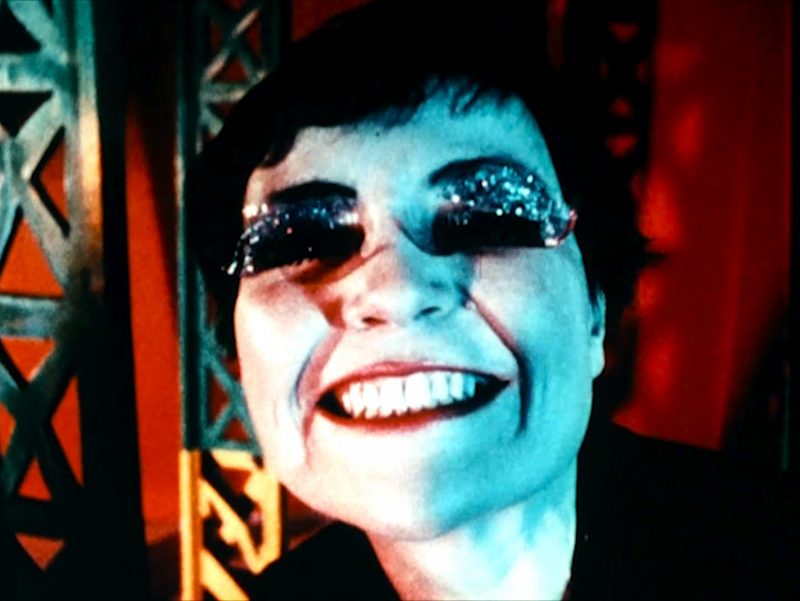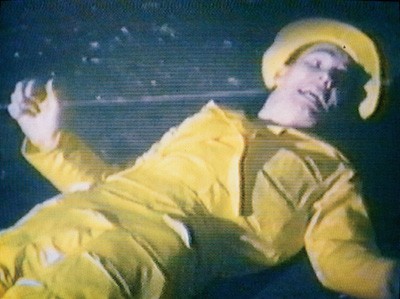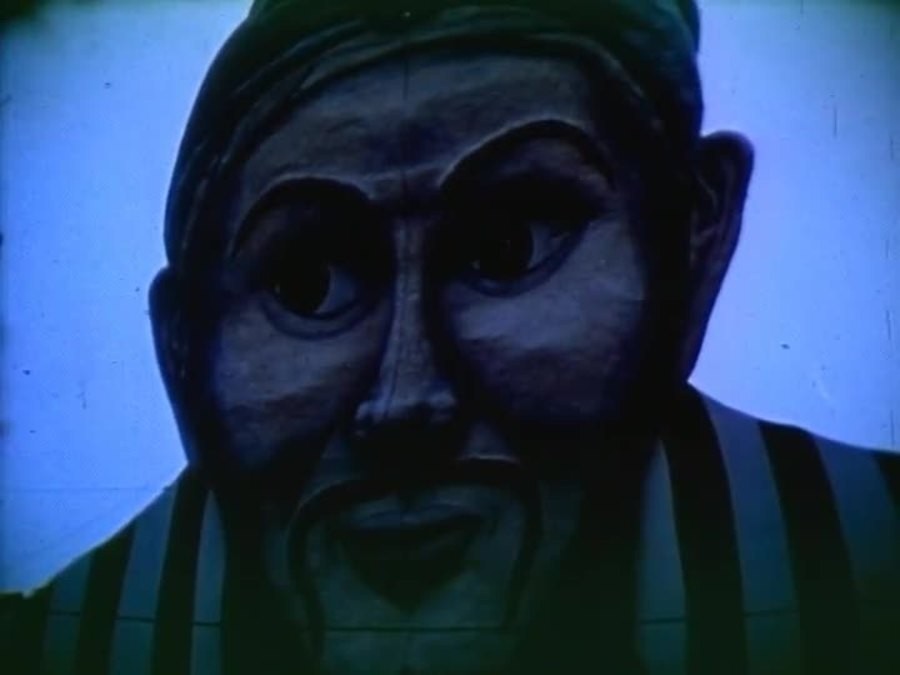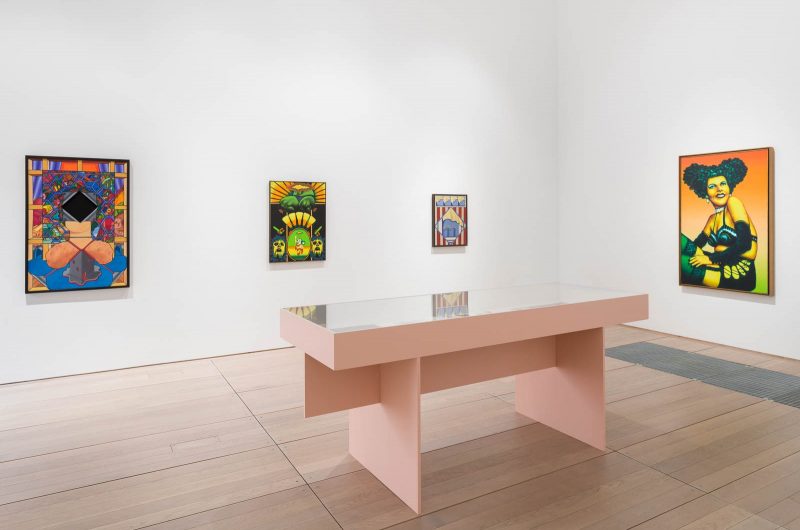Film Cycle: The Banana Man, the Tattooed Lady, and other stories…
Running in parallel to How Chicago! Imagists 1960s & 70s, the three-part cycle of film screenings aimed to convey the Imagist spirit, the city that inspired them, and the lasting influence they had on artists that came after, such as Mike Kelley.
Red Grooms, Tappy Toes, 1968
15 Mar–8 April
“Everyday I sit on the steps of the Art Institute and watch the girls go by…” Tappy Toes, or the ‘last underground musical’, was shot in the 60s by fellow School of the Art Institute of Chicago artist Red Grooms. Imagist Ed Flood acted as cinematographer, and it variously stars performances by artists Ed Paschke, Lori Gunn, Karl Wirsum, Sarah Canright, and Richard Hunt. A flamboyant counter-cultural ode to Chicago and artists working there, the action includes passages of surreal animation and satirises Mayor Daly’s heavy-handed governance of the city.
Duration: 19’04” looped
Mike Kelley, The Banana Man, 1989
8 April–6 May
Artist Mike Kelley has often cited Jim Nutt as being an influence on his work, particularly his painting on Plexiglass – which he read as humorous ripostes to Clement Greenberg’s search for flatness. His irreverent use of humour and popular culture as a layered and powerful language, speaks to the Imagists own non-hierarchical approach to vernacular forms. Here, in his first complete video work, Kelley interprets a children’s TV character taken from Captain Kangaroo, basing his interpretations on others’ descriptions, having never watched the show himself. His manic and melancholic character navigates slippery language and vivid tableaux; such as ‘blind justice’ ‘mis-carrying’ objects, to create an absurd physical comedy.
Duration: 28’15” looped
Tom Palazzolo, the Tattooed Lady of Riverview Park, 1967
6–27 May
The once teeming Riverview Park in Chicago was shut down in 1967 (with Tom Palazzolo on hand to document the bitter end). The film is a portrait of its final occupant, Jean Furella, the tattooed lady. Furella first tells how she used to work at the sideshow as a bearded lady but fell in love with a man who asked her to shave. She then gives her carnival barker’s spiel one more time for the camera. Quick cuts between frenetic shots of Riverview Park, in use and full of life, and later images of its demolition-in-progress lend to the carnival atmosphere. The film is contemporaneous with the Imagist moment, and shows a similar fascination for the sub cultures of Chicago – Ed Pashke was directly influence by fairgrounds and the carnival performers that populated them. Images of various tattooed men were used as wall captions for works in the Hairy Who II exhibition in 1976, and many Imagist artists adopted tattoo designs in their works.
Duration: 13’45” looped
The films ran in the Oak Gallery, and were on show during regular exhibition opening hours.
Running in parallel to How Chicago! Imagists 1960s & 70s, the three-part cycle of film screenings aimed to convey the Imagist spirit, the city that inspired them, and the lasting influence they had on artists that came after, such as Mike Kelley.
Red Grooms, Tappy Toes, 1968
15 Mar–8 April
“Everyday I sit on the steps of the Art Institute and watch the girls go by…” Tappy Toes, or the ‘last underground musical’, was shot in the 60s by fellow School of the Art Institute of Chicago artist Red Grooms. Imagist Ed Flood acted as cinematographer, and it variously stars performances by artists Ed Paschke, Lori Gunn, Karl Wirsum, Sarah Canright, and Richard Hunt. A flamboyant counter-cultural ode to Chicago and artists working there, the action includes passages of surreal animation and satirises Mayor Daly’s heavy-handed governance of the city.
Duration: 19’04” looped
Mike Kelley, The Banana Man, 1989
8 April–6 May
Artist Mike Kelley has often cited Jim Nutt as being an influence on his work, particularly his painting on Plexiglass – which he read as humorous ripostes to Clement Greenberg’s search for flatness. His irreverent use of humour and popular culture as a layered and powerful language, speaks to the Imagists own non-hierarchical approach to vernacular forms. Here, in his first complete video work, Kelley interprets a children’s TV character taken from Captain Kangaroo, basing his interpretations on others’ descriptions, having never watched the show himself. His manic and melancholic character navigates slippery language and vivid tableaux; such as ‘blind justice’ ‘mis-carrying’ objects, to create an absurd physical comedy.
Duration: 28’15” looped
Tom Palazzolo, the Tattooed Lady of Riverview Park, 1967
6–27 May
The once teeming Riverview Park in Chicago was shut down in 1967 (with Tom Palazzolo on hand to document the bitter end). The film is a portrait of its final occupant, Jean Furella, the tattooed lady. Furella first tells how she used to work at the sideshow as a bearded lady but fell in love with a man who asked her to shave. She then gives her carnival barker’s spiel one more time for the camera. Quick cuts between frenetic shots of Riverview Park, in use and full of life, and later images of its demolition-in-progress lend to the carnival atmosphere. The film is contemporaneous with the Imagist moment, and shows a similar fascination for the sub cultures of Chicago – Ed Pashke was directly influence by fairgrounds and the carnival performers that populated them. Images of various tattooed men were used as wall captions for works in the Hairy Who II exhibition in 1976, and many Imagist artists adopted tattoo designs in their works.
Duration: 13’45” looped
The films ran in the Oak Gallery, and were on show during regular exhibition opening hours.
Read Less...



